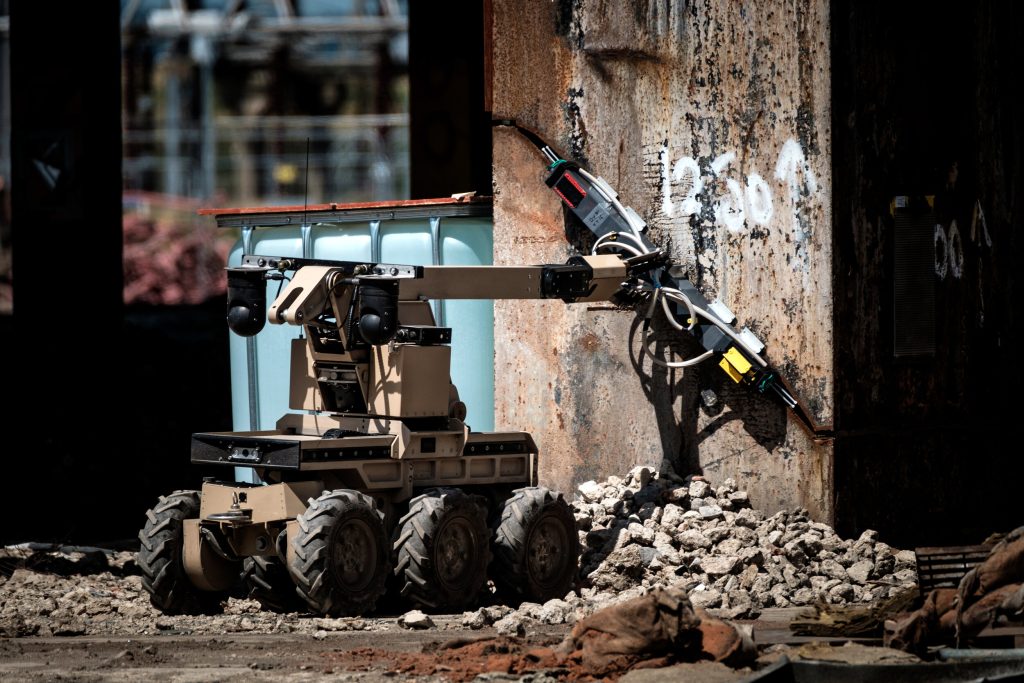Home >
Website Glossary
Abandoned Explosive Ordnance (AXO)
Explosive ordnance becomes Abandoned Explosive Ordnance (AXO) when a party to an armed conflict leaves it behind or dumps it after not using it in the conflict and then loses control of it.
Air Blast
Air Blast is the shockwave produced by the detonation of explosives, which can cause damage to nearby structures.
Airburst
An airburst is the explosion of a bomb or projectile above the surface, as opposed to an explosion on contact with the surface or after penetration.
Ammunition
A device filled with explosives, propellants, pyrotechnics, initiating materials, or nuclear, biological, or chemical substances intended for military operations, including demolitions.
Bangalore Torpedo
An explosive charge used primarily in military operations to clear obstacles, such as barbed wire, minefields, or other barriers. Originally devised in 1912, it consists of a long metal tube filled with explosives, typically connected in sections to create a more extended device. The term ‘Bangalore’ originates from its use by the British Indian Army in Bangalore, India, during World War I.
Binary Liquid Explosives
Binary liquid explosives are composed of two components that are stable when stored separately but become highly explosive when mixed in the correct proportions. The components of binary liquid explosives are usually non-explosive or minimally explosive independently, making them safer to manage and transport than traditional explosives. However, when mixed they undergo a chemical reaction rapidly producing a highly explosive compound.
Blast Radius
The blast radius is the area around an explosive device within which the effects of the detonation, such as blast pressure, heat, and fragmentation, can cause damage or injury.
Blast Wave
A blast wave is generated by the rapid expansion of hot gases in the atmosphere after an explosion. It starts as a shock wave and then decays into a sound wave.
Blasting Cap
A Blasting Cap is a small detonator that initiates detonation in the main explosive charge. There are two types: regular delay and short-interval, or millisecond delay.
Bomb
A bomb is a munition containing an explosive or other destructive agent designed for delivery by hand, gravity (from aircraft), or a low-velocity launch system (such as a mortar), to cause destruction, damage, injury, or death.
Bomb Suit
Bomb suits are protective ensembles worn by EOD technicians to shield them from the effects of a potential explosion. They typically consist of a helmet, visor, body armour, and gloves.
Booby Trap
A booby trap is a device, either explosive or non-explosive, specifically designed to cause harm when a seemingly harmless object is disturbed or when a typically safe action is taken.
Breaching
The tactical operation of creating an opening or entry point in a barrier, such as a wall, door, fence, or obstacle, typically to gain access to a structure or area during military, law enforcement, or emergency response operations. Breaching techniques may involve the use of various tools and methods, including explosives, cutting charges, mechanical breaching tools (such as hydraulic rams or saws), ballistic breaching (using firearms), or manual methods (such as battering rams or sledgehammers). Breaching is critical to many tactical operations, including hostage rescue, building clearance, and urban warfare scenarios.
CBRN
CBRN is an acronym representing Chemical, Biological, Radiological, and Nuclear materials or events. It encompasses various threats involving hazardous substances that can cause harm through contamination, poisoning, radiation exposure, or detonation. CBRN incidents require specialised preparedness, response, and mitigation strategies.
Controlled Explosion
A controlled explosion is an occasion when an EOD Operator uses a deliberate explosive technique to neutralise an Improvised Explosive Device (IED) during Render Safe Procedures.
Conventional Munitions Disposal (CMD)
The process of safely and effectively neutralising and disposing of conventional munitions, which are military weapons and ordnance designed for use by armed forces, including artillery shells, bombs, grenades, rockets, missiles, and small arms ammunition.
Counter-Improvised Explosive Device (C-IED)
The strategies, tactics, technologies, and operations employed to detect, prevent, neutralise, and mitigate the threat posed by improvised explosive devices (IEDs). C-IED encompasses a range of activities conducted by military, law enforcement, and security agencies to counter the use of IEDs by insurgents, terrorists, or other adversaries.
Countermine
Countermine encompasses the range of military procedures, techniques, and technologies employed to detect, breach, and neutralise enemy minefields and individual mines. It includes reconnaissance, mechanical and manual mine clearance, explosive breaching, and specialised equipment to ensure the safe passage of personnel and vehicles.
Cutting Charge
An explosive device specifically designed to slice through materials such as metal, concrete, or other structural components. Used in applications where precision cutting or breaching is required, cutting charges are typically composed of a shaped explosive charge that focuses the force of the explosion in a specific direction to achieve a clean and controlled cut. They are often used in conjunction with other demolition or breaching tools to create openings in structures or obstacles. Cutting charges vary in size and design depending on the intended application and target material.
Deflagration
Deflagration is a rapid combustion process in which a substance burns swiftly, propagating through a material at a subsonic speed. Unlike detonation, which involves a supersonic shockwave, deflagration occurs when a flame front moves progressively through a substance, consuming it as it goes. While deflagration is a rapid process, it is less violent and destructive than detonation.
Demining
Demining refers to activities to remove hazards posed by landmines and unexploded ordnance (UXO). This process includes technical surveys, mapping, clearance operations, marking hazardous areas, documenting post-clearance results, liaising with local communities regarding mine action, and handing over cleared land. Various organisations, such as non-governmental organizations (NGOs), commercial companies, national mine action teams, and military units, can carry out demining operations. These efforts can be either emergency-based or developmental in nature.
Demolition Charges
Explosive devices specifically designed to destroy or dismantle structures, vehicles, obstacles, or other targets in a controlled manner. Demolition charges vary in size, shape, and explosive power, depending on the nature of the target and the desired outcome.
Detonating Cord / Det Cord
A flexible, tubular explosive device consisting of a core of high explosives – usually PETN (pentaerythritol tetranitrate) or RDX (cyclotrimethylenetrinitramine) – encased in a waterproof outer covering. Det cord rapidly transmits a detonation wave along its length with high velocity for applications where precise and controlled initiation of explosive materials is required, such as in demolition, quarrying, and military operations. It is ideal for initiating large charges of high explosives simultaneously or in situations where conventional detonators may not be suitable. Det cord is highly regulated, requiring specialised training for handling and use.
Detonation
Detonation is the rapid and complete explosive decomposition of a material, characterised by a supersonic reaction front. This process is utilised in various applications, including demolition, mining, and propulsion, where the controlled release of high energy and pressure is required. Detonations can be categorised as either high-order or low-order, depending on the completeness of the reaction and the resulting energy output. A high-order detonation is characterised by a complete and efficient conversion of the explosive material, resulting in maximum energy release and a powerful shockwave. Conversely, a low-order detonation indicates an incomplete or inefficient reaction, producing less energy and a weaker shockwave. Understanding the factors that influence the order of detonation is crucial for the safe and effective use of explosives.
Detonator
A device used to initiate the detonation of an explosive material, typically consisting of a small, sensitive explosive charge or other mechanism that, when activated, generates a shockwave or ignition source to trigger the main explosive charge. Detonators play a crucial role in controlling the timing and sequence of explosive events, ensuring safety and precision in explosive operations. Detonators can be electrically, mechanically, or chemically activated, depending on the application’s specific requirements.
Disruptor
Disruptors are devices or technologies used by EOD operators as bomb mitigation solutions. Their primary purpose is to remotely detonate or disable explosive devices from a safe distance.
EOD Robot
A remotely operated vehicle equipped with cameras, sensors, and manipulator arms used by EOD technicians to inspect, handle, and dispose of explosive devices from a safe distance.
EOD Technician
Highly trained personnel responsible for identifying, assessing, and disposing of explosive threats, often working in high-stress and dangerous environments.
Explosion
An explosion is a rapid chemical reaction or change of state that generates high temperatures and usually produces a large volume of gas. This process creates a shock wave in the surrounding environment. The term ‘explosion’ encompasses both deflagration and detonation.
Explosive Booster
An explosive booster is a sensitive explosive charge that serves as a bridge between a relatively weak conventional detonator and a low-sensitivity explosive, such as TNT, which typically has high energy. The initiating detonator alone does not provide enough energy to ignite the low-sensitivity charge. Instead, it detonates the booster, creating an explosive shockwave powerful enough to detonate the secondary high-energy charge.

